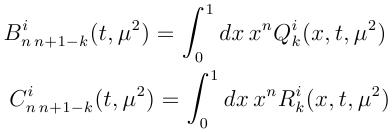Comparison to DVCS data
Compton Form Factors
of proton and neutron
(with downloads) DVCS asymmetries
ALU, AC and AUT
of proton and neutron
(with downloads) Nuclear GPDs and nuclear
DVCS asymmetries
(with downloads)
Back to V.Guzey at PNPI
This was explained and corrected in our recent paper (V. Guzey and T. Teckentrup, Phys. Rev. D. 79 , 017501 (2009) [arXiv:0810.3899 [hep-ph]]).
As a result, the good agreement with the high-energy DVCS data (H1 and ZEUS) is no longer possible in the minimal model of the dual parameterization.
All expressions, plots, data files (grids) and Fortran codes given below are up-to-date, i.e. with the restored factor of two and the correct forward limit of the generalized parton distributions.
Description of the model
The dual parameterization of nucleon Generalized Parton Distributions (GPDs) is built as a formal infinite and divergent series reproducing Mellin moments of the nucleon GPDs. The parameterization is called dual because its derivation is based on the hypothesis of duality: the resulting nucleon GPDs are presented as infinite sums of t-channel exchanges. The advantages of the dual parameterization include:
The dual parameterization for the nucleon GPDs H and E reads (the singlet combination which has the quark+antiquark sum in the forward limit):
 |
Cn3/2 are Gegenbauer polynomials; Pl are Legendre polynomials;
i is the quark flavor.
The way to work with the above divergent series is to introduce the generating functions Qk and Rk (Shuvaev transform):

|
With this trick, the expressions for the GPDs become explicitly finite:
 |
The expressions for the GPDs H and E
are organized as series in terms of xikQk.
Therefore, at sufficiently small xi, the series can be truncated.
The minimal model of the dual parameterization
consists in keeping only the generating functions Q0
and Q2
for H and R0
and R2 for E.
The generating functions Q0 and R0
are expressed in terms of the following forward distributions:

|
Within the dual parameterization, the t-dependence of the GPDs should be modeled separately. Two models were considered:
(preferred) |
 |
| |
|
 |
 |
|
 |
The Compton form factors (CFFs) have a simple form in terms of the generating functions:
 |